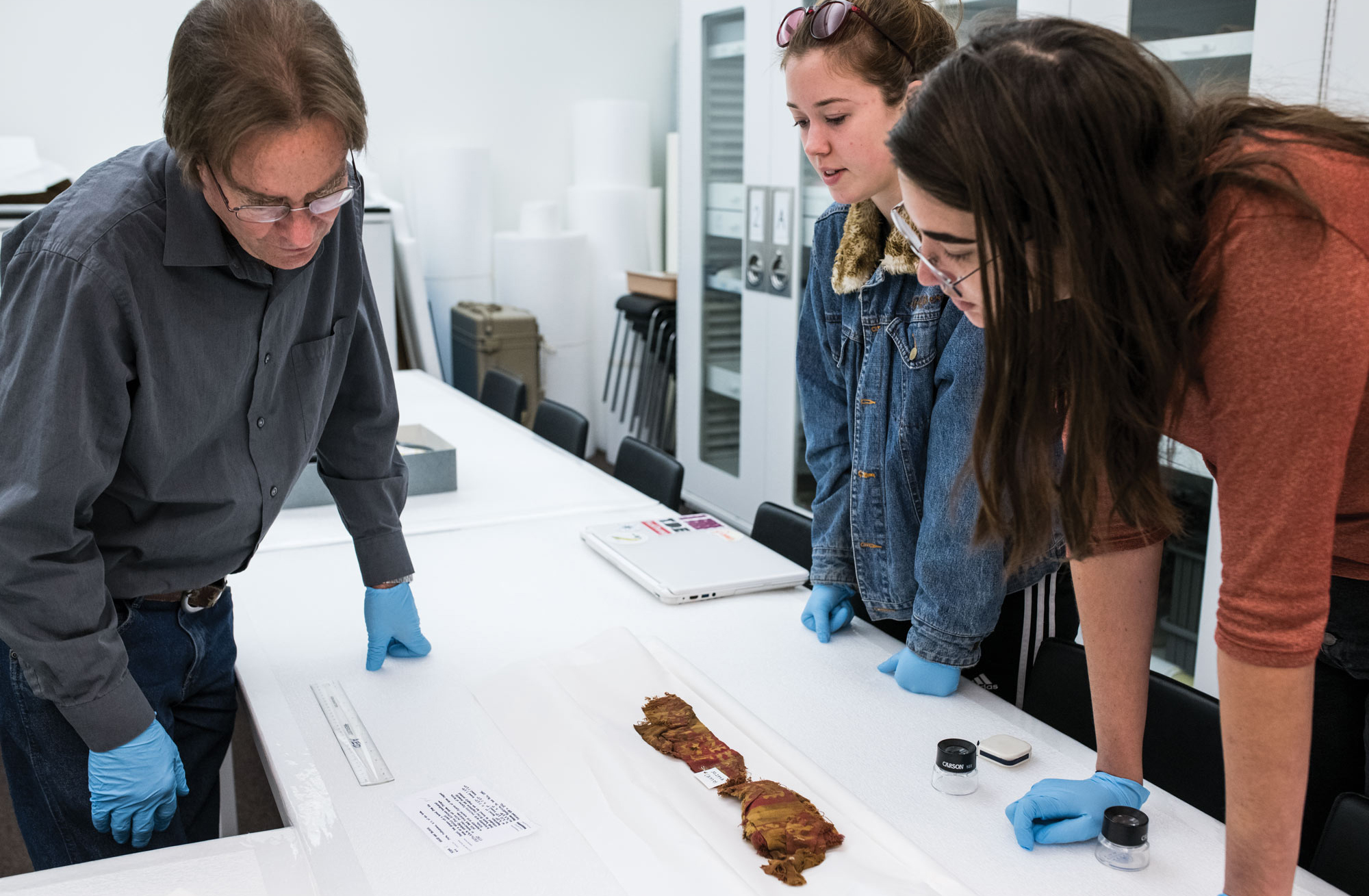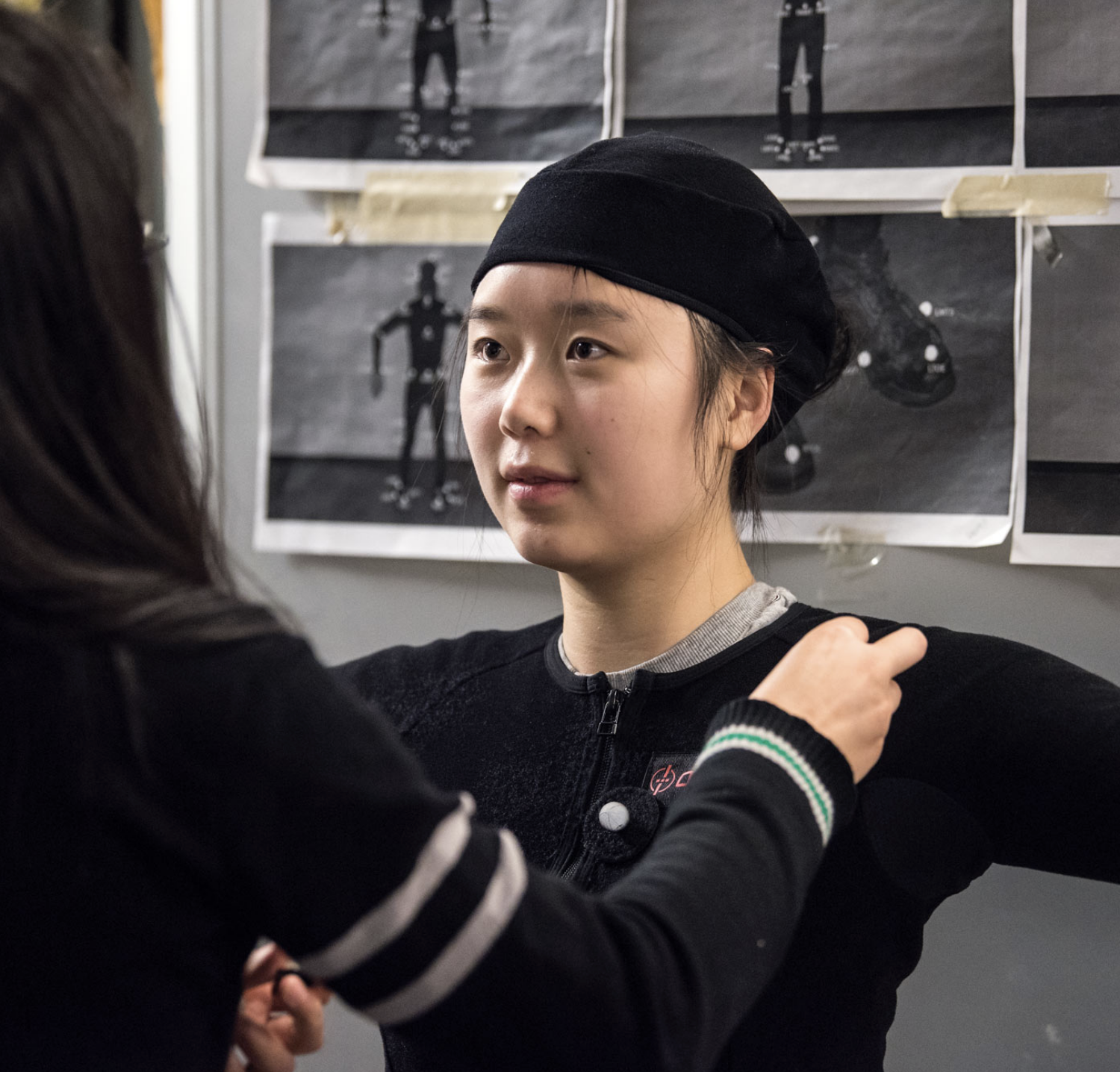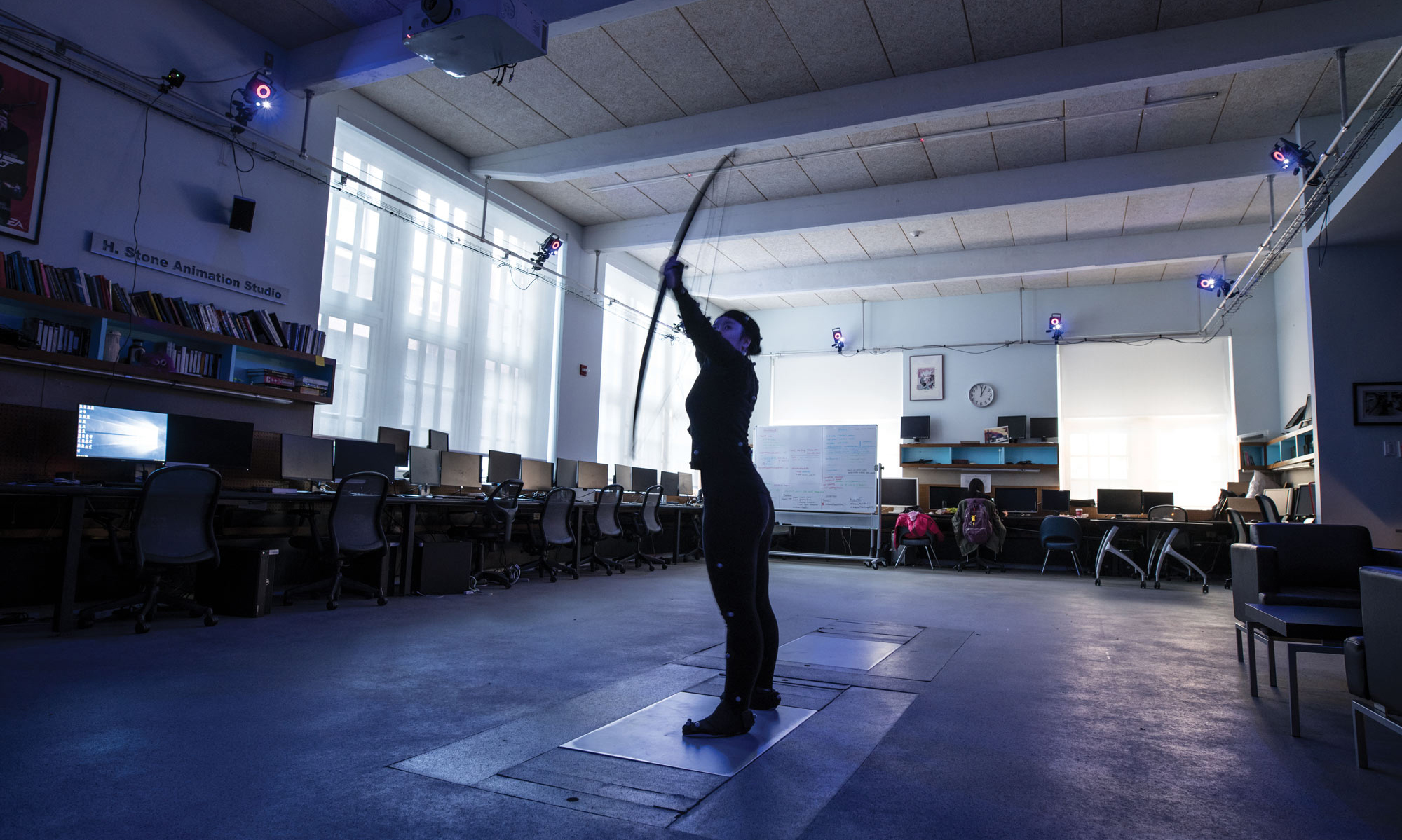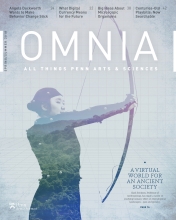A Virtual World for an Ancient Society
Clark Erickson, Professor of Anthropology, has made a career of studying humans’ effect on their physical landscapes—past and present.
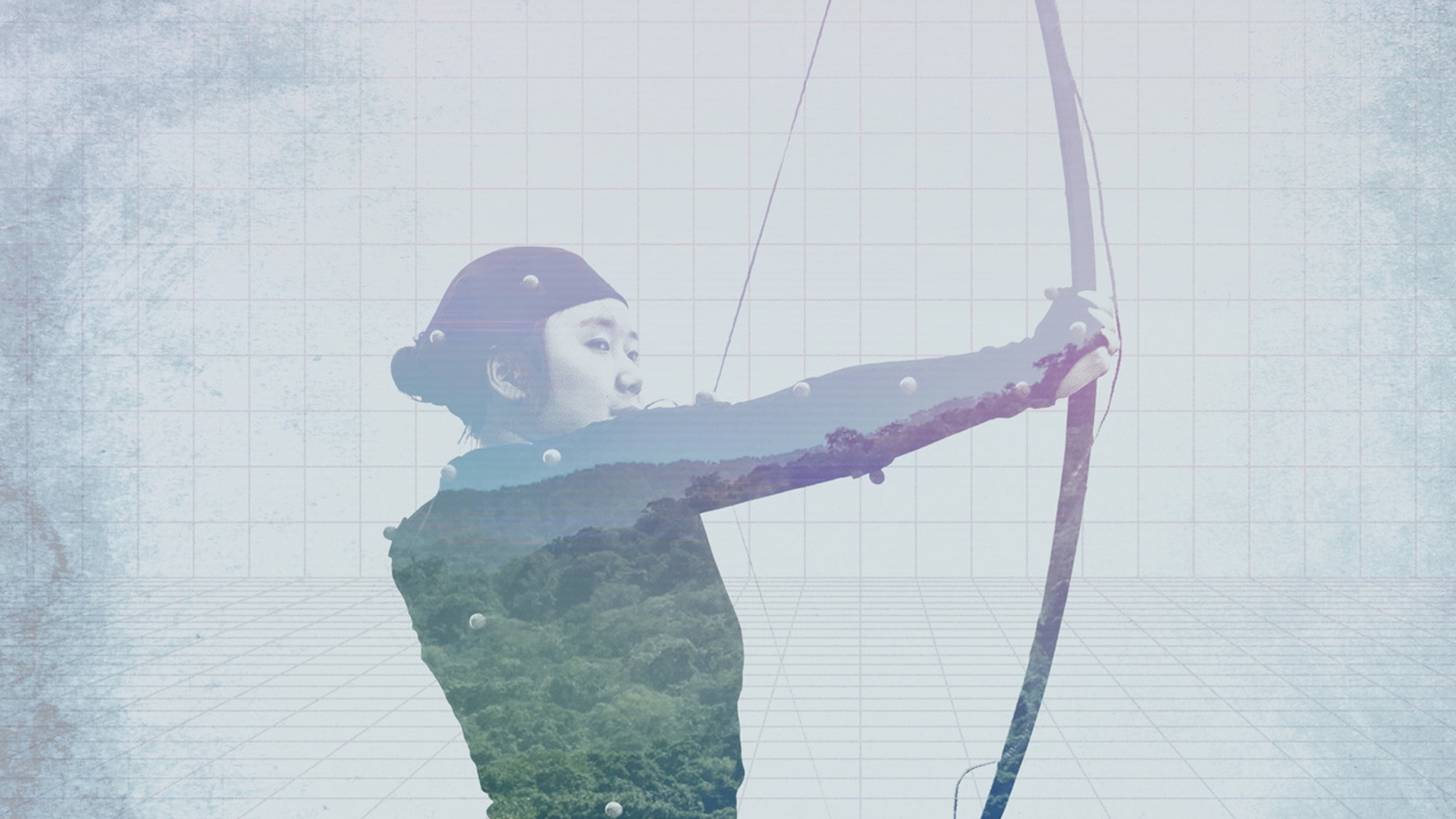
One student wields a bow and arrow, another a stone axe. A third lies in a hammock. It’s all part of Professor of Anthropology Clark Erickson’s resolution to put people into our picture of the past, and to understand how what they did affects our world today.
Most depictions of past civilizations have no human context: They’re sterile computer images of recreated temples or museum displays of relics. Erickson realized his own tendency to unconsciously dehumanize the past when he was a graduate student. “Archeologists learn about people through their stuff, so the stuff sometimes becomes more important than the people,” he says. “We make stuff the subject of sentences. Show stuff on slides. I decided as much as possible to make people the subject of the sentence.”
During his career studying the relationship between people and land in pre-Columbian agricultural societies in Peru and Bolivia, Erickson has authored three books and dozens of articles, each illustrated with drawings and paintings produced by an artist colleague, Dan Brinkmeier. As Curator-in-Charge of the American section of the Penn Museum, Erickson has designed innovative exhibits that include modern items next to ancient, recordings of Native Americans, and even projects by contemporary artists.
A virtual past world, The Pre-Columbian Hydraulic Landscape of Baures, Bolivia, is Erickson’s latest project to make people the subject of the sentence. He’s involving undergraduates in this endeavor—they’re being recorded as they use implements from the era, to create animations of the people of that time and modeling architecture, earthworks, and individual objects in 3-D, many from the collections of the Penn Museum. These will become part of an immersive digital world that will let us see that era complete with its inhabitants living everyday life in their cultural landscapes.
For Erickson, understanding these societies is also about taking human agency and intentionality into account in our view of the world today, for a long-term perspective on environmental change, biodiversity, and sustainable management. He believes that humans have been leaving their mark on the Earth—for better and for worse—for a very long time.
As he sees it, “Moving beyond the myths of pristine environment and the ecologically noble savage and the assumptions that most human activities affect the environment negatively lets one appreciate the human creativity, agency, and traditional environmental knowledge that was employed to domesticate landscapes for human use.”
Patterning on the Past
Archaeologists realized in the 1960s that parts of South America once thought to be primeval were actually riddled with patterns that must have been caused by humans. Systems of built-up earthen platforms surrounded by canals, these “raised fields” were found in wetlands or places where a dry season alternates with rains, such as much of the Amazon region.
“You get standing water and waterlogged soils that make the land very difficult to use for anything. But for some reason, early people sought out those landscapes and figured out ways to raise up the earth,” says Erickson. “It brought up the usual big questions: Who? Why? How? What did they grow? And what was life like for the people who did this?”
Many of his colleagues, he says, see American archeology through a political economy theory, looking at formation of classes, equality, and the use of ideology and power by allies. “That’s the case in many situations. But from my perspective, having lived in rural communities, a lot of it has to do with whether the people have an investment in the land, meaning that they own the land and they make improvements to the land that they can pass down to their sons and daughters.” Over time, these management practices transform environment into productive cultural landscapes, often sustaining large populations for centuries or longer.
As an undergraduate at Washington University in St. Louis, Missouri, Erickson spent time working alongside community farmers in Bolivia, which he says helped him understand how to use analogies of people today to understand the past and how to see what has changed. While a graduate student at the University of Illinois, Urbana-Champaign, he built a (small) raised field of his own, then designed a project that used traditional archaeological methods as well as experimental archaeology to recreate the raised fields in South America in collaboration with Quechua farmers.
“Experimental archaeology means taking the evidence that exists today, like a forensic scene, and using reverse engineering to figure out how it worked,” he says.
Erickson spent three and a half years in the Peruvian Highlands near Lake Titicaca, working with the local Quechua people to create, plant, and harvest raised fields. The project began to receive support from the government of Peru and interest from the United Nations, CARE, USAID, local NGOs (non-governmental organizations), and indigenous communities who wanted to use traditional technologies for sustainable development. Before violence accompanying a communist movement and the government response ended most projects in Peru in 1986, they had 24.7 acres of raised fields in use. Raised fields could work in the contemporary world.
Bringing the Past to Life
Erickson remembers his first tour of the Penn Museum, when he came to the University as an assistant professor in 1988. “It seemed like miles and miles of shelves packed with Andean and Amazonian ethnographic and archaeological objects,” he says. “I was just thinking, oh, I could use all these for my teaching.”
Many of these artifacts are now becoming part of The Pre-ColumbianHydraulic Landscape of Baures virtual world. This fall, Erickson and Norman Badler, Rachleff Family Professor of Computer and Information Science in Penn Engineering, taught Visualizing the Past/Peopling the Past. In the class, students helped populate a virtual world that will ultimately show a thriving landscape complete with hundreds of people going about their everyday lives—walking, paddling canoes, hunting, making fires, socializing, cutting down trees, tending fields, and sleeping in hammocks.
Experimental archaeology means taking the evidence that exists today, like a forensic scene, and using reverse engineering to figure out how it worked.
In the class, students critiqued previous representations of the past—often unconsciously biased by implicit assumptions and stereotypes about gender, race, and class in professional writing, artistic reconstructions, museum exhibits, technical illustration, textbooks, and popular culture like film, magazines, and documentaries. The students learned to think not only of the people who lived then, but also the viewpoint, assumptions, and logic, in visualizing and peopling the past, of those who created the representation.
“One of the most interesting things was the social aspect of presentation of ancient people and how a lot of that is influenced by our social politics,” says Julia Bell, C’19. “We would talk about whether virtual reality models in museums could make things more or less democratic.”
Students researched and studied items ranging from weapons, stone axes, and canoes to household items like hammocks; cooking, food processing, and storage vessels; beer-drinking bowls; baskets; and fish traps. Using the ViDi Center for Digital Visualization, they created a digital model of the object, then used a state-of-the-art motion capture system to perform and animate how it was used. Along the way they learned to use contemporary 3-D modeling tools and animation engines.
Badler emphasizes that the students do not use 3-D scanning to create the digital versions of the objects. Instead, students must study every detail of the item and figure out how to build the 3-D model from scratch, a process that parallels how the object was originally put together. The students also did library research about specific objects and how they were made and used within Amazonian cultures.
“When you think of a bow, it’s a piece of wood and a string,” says Badler. “But the students get down to really modeling the appearance and shape of the ropes and twine that are used to make it. The level of detail they had to get to was not something they would have been able to experience any other way.”
Bell and her team modeled a hammock. “It was hanging on a wall, and we had to make it look like it was organically hanging from something with gravity pulling on it. If you think of pulling a hammock taut, it’s so instinctive, but to actually translate that into a model is a lot of trial and error,” she says. “Then when we put the texture on the model so it looked real instead of just a white blob hanging there, the difference was really vivid.”
“The students are working to create an immersive experience that we could turn into an educational game,” says Erickson. An early version of the virtual world constructed in a modern 3-D game engine opens with a bird’s-eye view, then swoops down to reveal fields, causeways, canals, fish weirs, and houses. Erickson points out that you can see the animated grass bending in a breeze and how it parts when a 3-D human model walks through it. “It’s just incredible,” he says.
Anthropology graduate student Justin Reamer says, “Clark is using the virtual world for outreach in public communities in Bolivia and getting their feedback. It can be a device to open up a conversation with the public and get them interested in archaeology. When you can say, here’s what we think the sites would look like, it allows more of a dialogue for interpretations and can make for involved and interested people.”
People Power
Erickson has continued his research on pre-Columbian raised fields and other earthworks in Bolivia. He became more interested in the aesthetics and sheer size of the earthworks, which covered hundreds of square miles. Some had earthen causeways or raised roads up to 40 feet wide and three miles long forming networks across the landscape.
“These fields and other public earthworks are not just functional,” he says. “They would have been these people’s versions of monuments, imposing order and inscribing it right on the landscape with these incredible causeway and canal systems for communication, transportation, farming, and fishing for very, very large communities.”
Erickson is now working with NASA using satellite and other imagery to determine if the people understood and were intentionally exploiting hydraulic principles. “Some of these earthworks were not just draining water but controlling it, to keep it on the landscape longer and to create fisheries, which provided them with protein.”
For Erickson, the pre-Columbian earthworks demonstrate what human communities can do, given time. “There were hundreds of years of people working these landscapes—using trial and error, working things out, understanding how to make that land productive.”
In doing so, Erickson says, they changed the face of the earth forever. The interface of artificial canals and earthworks created new, rich, and productive transitional zones between aquatic and terrestrial life. Raised fields changed soil profiles as far as a yard or more below the surface, full of archaeological remains. By selecting and encouraging species of plants and animals they found useful, the farmers altered the character of their environment. Even before farming, systematic landscape burning strategies undertaken by hunter-gatherers for managing useful resources have shaped most ecologies in the world.
Erickson is using all of his tools to spread the word (and images). “Indigenous cases of successful landscape domestication need to be translated through popular media into practical solutions for the problems we face today,” he says. “We need to use drawing, painting, technical illustration zines, digital modeling, virtual reality, animation, and collaboration with science writers.” He’s collaborated with his long-time illustrator Dan Brinkmeier to start several zines that teach people about raised field agriculture and fish weirs. One, written in English and Quechua, is for younger readers and describes the history of the region.
“People can change the environment more now than in the past, but early humans did not tiptoe through the forest leaving only footprints,” says Erickson. “And nature just didn’t grow back to some pristine state. Nature never does that.”
He argues that, far from being limited by their environment, the people in pre-Columbian South America domesticated the land itself. “They had the ingenuity to figure things out. These societies were successfully packing a lot of people on landscapes using very effective techniques to make those lands productive and sustain a good life.”
